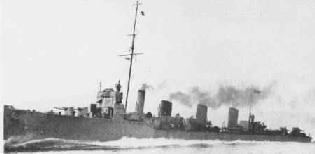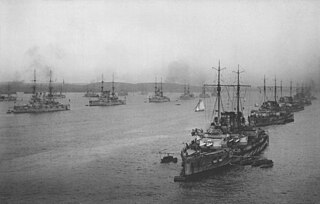
The Battle of Jutland was a naval battle fought between Britain's Royal Navy Grand Fleet, under Admiral Sir John Jellicoe, and the Imperial German Navy's High Seas Fleet, under Vice-Admiral Reinhard Scheer, during the First World War. The battle unfolded in extensive manoeuvring and three main engagements, from 31 May to 1 June 1916, off the North Sea coast of Denmark's Jutland Peninsula. It was the largest naval battle and the only full-scale clash of battleships of the war. Jutland was the third fleet action between steel battleships, following the Battle of the Yellow Sea in 1904 and the Battle of Tsushima in 1905, during the Russo-Japanese War. Jutland was the last major battle in history fought primarily by battleships.

HMS Malaya was one of five Queen Elizabeth-class battleships built for the Royal Navy during the 1910s. Shortly after commissioning in early 1916, she participated in the Battle of Jutland of the First World War as part of the Grand Fleet. In the Second World War, Malaya served mostly in escort duties in the Mediterranean Sea and Atlantic Ocean. She was withdrawn from service at the end of 1944, and sold for scrap in 1948.

The Grand Fleet was the main battlefleet of the Royal Navy during the First World War. It was established in August 1914 and disbanded in April 1919. Its main base was Scapa Flow in the Orkney Islands.

HMS Tipperary, launched on 5 March 1915, was a Royal Navy Faulknor-class destroyer which was sunk in action on 1 June 1916 by the Imperial German Navy at the Battle of Jutland in World War I.

HMS Nottingham was a Town-class light cruiser built for the Royal Navy just before World War I. She was one of three ships of the Birmingham sub-class and was completed in early 1914. The ship was assigned to the 1st Light Cruiser Squadron (LCS) of the Home and Grand Fleets for her entire career. Nottingham participated in most of the early fleet actions, including the battles of Heligoland Bight, Dogger Bank, and Jutland, helping to sink several German ships during the battles. The ship was sunk by the German submarine U-52 during the Action of 19 August 1916.

Major Francis John William Harvey, VC was an officer of the British Royal Marine Light Infantry during the First World War. Harvey was posthumously awarded the Victoria Cross, the highest military award for gallantry in the face of the enemy given to British and Commonwealth forces, for his actions at the height of the Battle of Jutland. A long-serving Royal Marine officer descended of a military family, during his career Harvey became a specialist in naval artillery, serving on many large warships as gunnery training officer and gun commander. Specially requested for HMS Lion, the flagship of the British battlecruiser fleet, Harvey fought at the battles of Heligoland Bight, Dogger Bank and Jutland.

The Active-class cruisers were a trio of scout cruisers built for the Royal Navy shortly before the First World War. They were initially assigned to the First Fleet and became destroyer flotilla leaders in 1914. Amphion and Fearless and their flotillas were assigned to the Harwich Force when the war began in August 1914. They went out on a patrol on the first day of the war and Amphion and her destroyers encountered and sank a German minelayer. On the voyage home, the cruiser struck a mine laid by the German ship and sank. She was the first ship of the Royal Navy to be sunk in the war.
The 3rd Battle Squadron was a naval squadron of the British Royal Navy consisting of battleships and other vessels, active from at least 1914 to 1945. The 3rd Battle Squadron was initially part of the Royal Navy's Home Fleet. During the First World War, the Home Fleet was renamed the Grand Fleet. During the Second World War, the squadron covered Atlantic convoys.

HMS Broke was a Faulknor-class destroyer leader of the Royal Navy, initially built for the Chilean Navy as the Almirante Lynch-class destroyer Almirante Goñi. The outbreak of the First World War led to her being purchased by the Admiralty in August 1914 shortly after her launching, and renamed HMS Broke. All of the class were present at the Battle of Jutland on 31 May to 1 June 1916, where Broke, out of control after hits from German ships, collided with the Acasta-class destroyerHMS Sparrowhawk, leading to the latter's loss. Broke saw action in several battles, and was resold to Chile after the conclusion of the war.
HMS Ophelia was an Admiralty M-class destroyer built for the Royal Navy during the First World War, entering service in 1916. The ship served at the Battle of Jutland on 31 May/1 June 1916, and sank a German submarine in 1918. She was sold for scrap in 1921.
HMS Narborough was an Admiralty M-class destroyer built for the Royal Navy during the First World War. She was wrecked after running aground in 1918.

The II Battle Squadron was a unit of the German High Seas Fleet before and during World War I. The squadron saw action throughout the war, including the Battle of Jutland on 31 May – 1 June 1916, where it formed the rear of the German line.

HMS Moresby was a Admiralty M-class destroyer which served with the Royal Navy during the First World War. The M class were an improvement on the previous L-class, capable of higher speed. Originally laid down as HMS Marlion by J. Samuel White at East Cowes on the Isle of Wight, the vessel was renamed before being launched on 20 November 1915. At the Battle of Jutland, the destroyer was initially cover for the seaplane tender Engadine but soon joined the action as part of a flotilla led by the light cruiser Champion. Moresby attacked the German fleet with torpedoes, initially unsuccessfully targeting the dreadnought battleship Markgraf and, near the end of the battle, unleashing another which narrowly missed the battlecruiser Von der Tann. In March 1918, the destroyer sank U-110 with the destroyer Michael. After the war, the destroyer was placed in reserve and eventually sold to be broken up on 9 May 1921.

HMS Nicator was an Admiralty M-class destroyer which served with the Royal Navy during the First World War. The M class was an improvement on the preceding L class, capable of higher speed. Launched in February 1916, the destroyer fought in the Battle of Jutland between May and June 1916, operating in support of the British battlecruisers in their action against the German High Seas Fleet. Nicator claimed, along with sister ship Nestor, the destruction of a German torpedo boat, likely to be V27. The destroyer also attacked the German battlecruisers and battleships and, although no hits were recorded, kept the German ships from closing with the British. This was crucial to limiting losses to the British battlecruiser fleet. The vessel was subsequently fitted with paravanes for anti-submarine warfare. After the war, the destroyer was placed in reserve and subsequently sold to be broken up in May 1921.

HMS Marvel was a Admiralty M-class destroyer which served with the Royal Navy during the First World War. The M class were an improvement on the previous L class, capable of higher speed. The vessel, launched in October 1915, joined the Twelfth Destroyer Flotilla under the flotilla leader Faulknor. The ship saw action during the Battle of Jutland in May and June 1916, being hit by a 12 in (300 mm) shell that did not explode and jointly sinking the German torpedo boat SMS V48. Six months later, the vessel successfully rescued all but four of the crew of the sinking flotilla leader Hoste, despite sustaining substantial damage in the process. In June 1917, the vessel was involved in the sinking of the German merchant ship SS Gamma in Norwegian waters, which led to a diplomatic protest from the Norwegian government. At the end of the war, the vessel was placed in reserve until being sold to be broken up in May 1921.

HMS Mystic was an Admiralty M-class destroyer which served with the Royal Navy during the First World War. The M class was an improvement on the previous L class, capable of higher speed. The vessel, originally named HMS Myrtle but renamed before being launched in 1915, joined the Grand Fleet as part of the Eleventh Destroyer Flotilla. The ship was assigned as part of a destroyer screen to protect the British battleships as they sought to destroy the German High Seas Fleet. During the Battle of Jutland in 1916, the destroyer saw action against German light cruisers and, as the evening fell, attacked the German battle line, but recorded no hits. During the following year, the vessel took part in a large anti-submarine patrol, but did not see any German submarines. Later in the war, the ship was transferred to the Coast of Ireland Station at Buncrana and escorted convoys at the start of their journey from ports on the Clyde and Mersey or at the end of their journey across the Atlantic Ocean. After the Armistice in 1918 that marked the end of the First World War, Mystic was placed in reserve before being decommissioned and subsequently sold to be broken up in 1921.

HMS Mindful was a Admiralty M-class destroyer which served with the Royal Navy during the First World War. The M class destroyers were an improvement on the previous L-class, capable of higher speed. The vessel, launched in 1915, joined the Twelfth Destroyer Flotilla under the flotilla leader Faulknor. The ship saw action during the Battle of Jutland in May 1916 and helped sink the German torpedo boat SMS V48. In March 1917, the destroyer was involved in a friendly fire incident, nearly sinking the British submarine G12. In June that year, the vessel was involved in the sinking of the German merchant ship SS Gamma in Norwegian waters, which led to a diplomatic protest from the Norwegian government. At the end of the war, Mindful was withdrawn from service and, in 1921, sold to be broken up.

HMS Onslaught was a Admiralty M-class destroyer which served with the Royal Navy during the First World War. The M class were an improvement on the previous L-class, capable of higher speed. The vessel, launched in 1915, joined the Twelfth Destroyer Flotilla under the flotilla leader Faulknor. The ship saw action during the Battle of Jutland in May 1916, jointly sinking the German torpedo boat SMS V48 and launching the torpedo that sank the pre-dreadnought battleship Pommern, the only German battleship to be lost in the battle. Subsequently, the destroyer acted as an escort to other naval ships during the Action of 19 August 1916 and took part in anti-submarine operations. At the end of the war, Onslaught was withdrawn from service and, in 1921, sold to be broken up.










